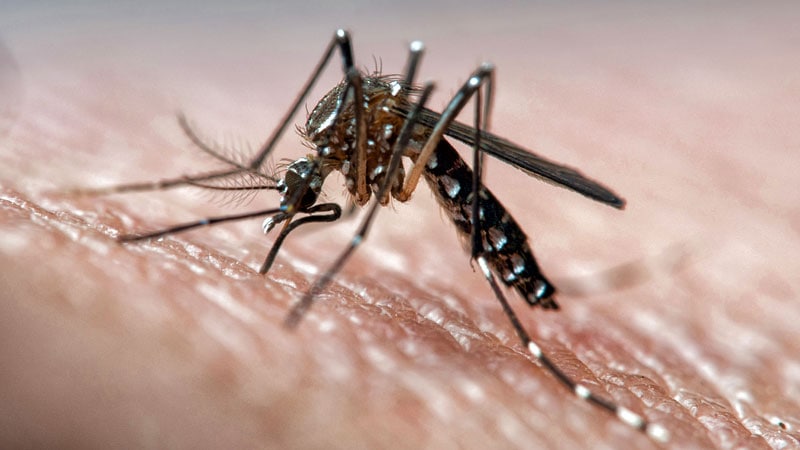Climate Change May Promote the Global Spread of Arboviruses
The World Health Organization (WHO) is sounding the alarm about a recent increase in arbovirus cases in various regions around the world. Cases are even being seen in cooler regions, a fact that officials attribute to the advance of climate change.
In Brazil, 1016 people died from dengue in 2022. Never in the country’s history has this disease caused so many deaths. Epidemiological data from the Ministry of Health show that the virus has spread to southern Brazil, where three states — Paraná, Santa Catarina, and Rio Grande do Sul — round out the top five in terms of the number of confirmed dengue deaths.
Medscape‘s Portuguese edition spoke with André Siqueira, MD, PhD, an infectious disease specialist and researcher at the Laboratory of Acute Febrile Diseases at the Oswaldo Cruz Foundation’s Evandro Chagas National Institute of Infectious Diseases. He explained that many states have never had a substantial number of cases of dengue, so the current situation is presenting real challenges for them.
“We’ve seen a significant increase in the number of cases of arboviruses, primarily dengue and chikungunya,” he explained. “These infections are even being seen in states that haven’t had a lot of experience handling them.”
In a press conference on the rise of dengue, Zika, and chikungunya outbreaks and the impact of climate change, WHO officials expressed great concern about the region of the Americas. These countries and territories have been particularly impacted by arboviruses, with worrying trends in cases and deaths. One of the speakers was Raman Velayudhan, PhD, the unit head of the WHO’s Global Program on the Control of Neglected Tropical Diseases for coordinating the dengue and arbovirus initiatives. In South America, countries further south on the continent like Bolivia, Peru, and Paraguay are recording more and more cases of dengue. According to Siqueira, “There are two main reasons why this is significant. First, because these are areas where the population didn’t have immunity [against the viruses that cause these diseases]. In other words, the susceptibility to infection was high. And second, the healthcare systems weren’t prepared to deal with the complexities that came with such a striking increase in the number of cases of these diseases.”
Siqueira emphasized that to combat arbovirus-associated mortality, there should be a focus on the prompt identification of patients who are at greater risk of developing severe cases. “There’s no specific treatment for any of those three arboviral diseases, [meaning Zika, dengue, and chikungunya]. What we have, in terms of management, is [the possibility of] establishing [a case’s] severity and hydrating [the patient] either orally or, in more serious cases, intravenously. And all of this needs to be set in motion as quickly as possible [at points of care].”
Expanding on his comments about the dengue situation in South America, Velayudhan stated that “climate change has played a key role in facilitating the spread of the vector, the mosquitoes, down south.”
He and his colleagues are also concerned about the situation in Europe. The vector mosquitoes — Aedes aegypti (present in Brazil) and Aedes albopictus (more common in Asia) — have been found there, with 24 countries reporting the presence of the vector mosquitoes, and with cases of dengue and chikungunya being reported since 2010. Although there is still no hard data from Asia, the WHO says that the trend “seems alarming.”
In addition to the rise in temperatures and the changes in rainfall patterns, which favor the proliferation of disease-transmitting mosquitoes, the WHO mentioned a few other reasons for the increase in the incidence of arboviruses worldwide: the acceleration of urbanization, which is associated with basic sanitation problems, and the fact that people are out and about again, travelling around locally and internationally now that COVID-19 restrictions have been lifted.
The WHO issued an alert on the increased incidence of chikungunya worldwide. To date, 115 countries have reported cases of the disease, which can cause chronic disabilities and have a major impact on quality of life.
“There’s still a tremendous lack of knowledge regarding chikungunya. It is a much more complex disease than one might think. It can bring about significant inflammation and, in some people, severe acute disease. It has a greater impact on mortality than one might expect,” said Siqueira.
Of these three diseases, Zika accounts for the smallest number of cases. Still, that virus is circulating, and this is yet another cause for concern for the WHO. To date, 89 countries have identified infections caused by that pathogen. Authorities are raising awareness not only about problems that the disease itself can cause, but also about complications, such as Guillain-Barré syndrome and congenital Zika syndrome.
The WHO has urged countries to pay particular attention to the spread of arboviruses, declaring, for its part, to be committed to the mission of expanding tools and resources for combating these diseases.
This article was translated from Medscape’s Portuguese edition.
Source: Read Full Article
